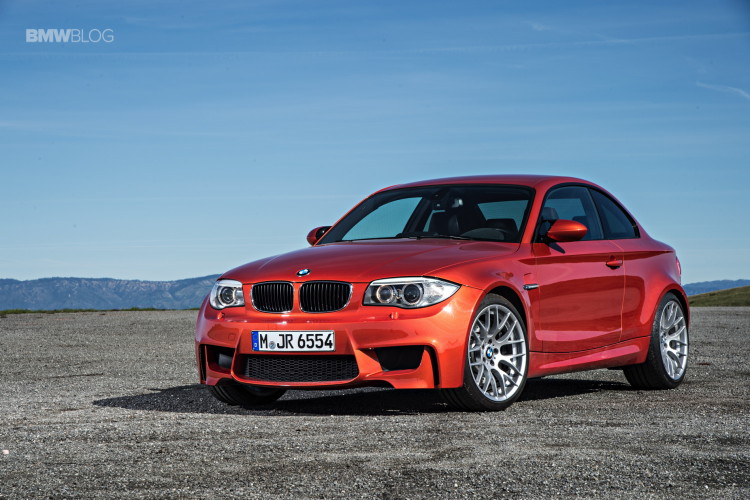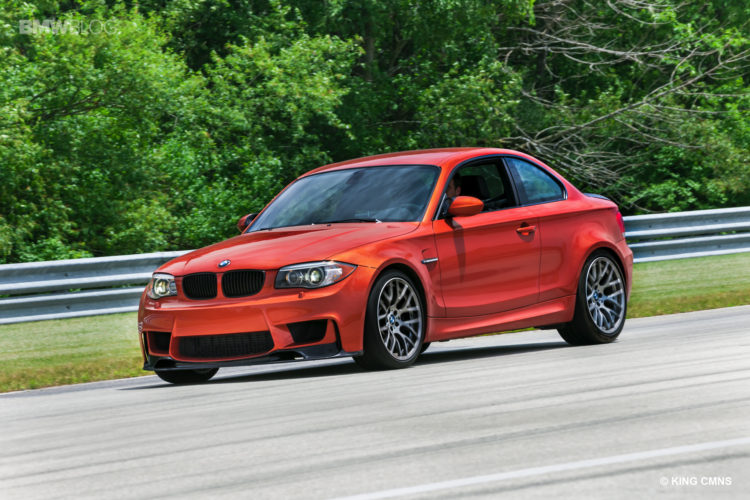Words: Perry Snijders & Andre de Vries – article published by Driving-Fun
Photo’s: Robin Hartog & Mark Kuijper
In April we had the opportunity drive the fastest 1 Series on Zandvoort race track, but after that, we had to wait quite some time for a new taste of one of the most exciting BMW’s in the recent years. However, this gave us time to arrange a test driving session with racing driver Andre de Vries. Furthermore, we got a chance to call some friends who happen to own M vehicles as well. Is the parts bin M good enough to take on the real M’s?
There has been much discussion around the new 1M. A turbocharged engine is widely regarded as being below BMW’s standards, and although it is a BMW M model, it hasn’t got a specific S-code engine as all legendary previous M models had, but rather an off the shelf standard BMW engine.
 The looks of the car have also been subject of heated debates. The profile of the 1 Series has been compared to the flabby belly of a boar and the coupé sparks even more controversy. The 1 Series Coupe lacks the stretched lines and elegance you expect from a car that is named a “coupé.” We don’t see that as a downside, and we rate this car as a classic two-door sports saloon. This type of sports saloon used to be quite common back in the day. Just look back at the sporty versions of the Ford Escort; they were very successful on circuits and in rallies in the late sixties. But this type of car is no stranger to BMW either, as the 2002, the E21 323i and the first model M3 were all two-door sports saloons.
The looks of the car have also been subject of heated debates. The profile of the 1 Series has been compared to the flabby belly of a boar and the coupé sparks even more controversy. The 1 Series Coupe lacks the stretched lines and elegance you expect from a car that is named a “coupé.” We don’t see that as a downside, and we rate this car as a classic two-door sports saloon. This type of sports saloon used to be quite common back in the day. Just look back at the sporty versions of the Ford Escort; they were very successful on circuits and in rallies in the late sixties. But this type of car is no stranger to BMW either, as the 2002, the E21 323i and the first model M3 were all two-door sports saloons.
Impossible not to get enthusiastic
As a car fanatic it is almost impossible not to get enthusiastic about the BMW 1M. A six in-line engine, rear wheel drive, a manual transmission and 340 bhp sounds like automotive bliss. The expectations that come with these specs are more than met by the 1 M. You are constantly challenged to enter a corner a little bit faster than usual or to exit a corner with the rear tires sliding in a smooth drift. This feature of the 1M is a drawback at the same time. It inspires the driver with so much confidence to explore the grip limits that we wouldn’t be surprised if it were to get a reputation as a treehugger, as did the 2002 and E21 323i in the past.
Although the short wheelbase can make the 1M tricky in some situations, this is not so much a flaw in the chassis setup as the consequence of over-eagerness on the part of the driver. The car’s limits are so high that you can only really exploit them at relatively high speeds. Even on twisty B-roads, speeds of over 100km/h are easily reached and at that point a small mistake can have significant consequences.
Standard engine of the shelf
To say that the 1M engine led to much debate among BMW fans would be an understatement. BMW M always had a specially designed engine; just think of the V8 engine in the M3 or the V10 in the previous M5. But for the 1 M, BMW decided to use an of the shelf engine, the inline six from the Z4 sDrive35is. This engine develops 340 bhp, with the help of twin-turbochargers. This is something that until recently would have been unthinkable in a BMW M model. The line was crossed when the M versions of the X5 and the X6 came to market with turbocharged engines, two highly controversial vehicles even to this date. On the other hand, the 1 M is the first truly sporty BMW M that is equipped with a turbocharged engine and already embraced by many.
However, turbocharge technology isn’t completely new to BMW. Over the last couple of years several new turbocharged engines have been presented, but in the 70s and 80s the brand also used turbocharged engines. In 1972, the BMW Turbo was unveiled, a predecessor of what was to become the M1 supercar. A little later, the legendary 2002 Turbo hit the showrooms and even the 7 Series was equipped with a six-cylinder turbocharged engine in 1979. When BMW presented the 323i in 1977, the general expectation was that a turbocharged version would soon follow. In the months prior to the introduction of the first M3, rumors had it that it would achieve its 200 bhp with the help of a turbocharger.
But we wanted to find out for ourselves whether a turbo-M can be just as good as a naturally-aspirated M. Seeing is believing which is why we called up some friends of www.driving-fun.com who happen to have some M cars in their garage. Erik owns a sharp E36 M3, Robert drives an E92 M3 and Bart brought along his Z4 M Coupe. And to make sure these cars could be tested to their full potential, we invited racing car driver Andre de Vries to join us in this unique test driving session.
Oldest M3 falls through
First in line was the classy E36 M3. The engine in the E36 may have been an engineering masterpiece to this date, but in direct comparison to the other three, cars it doesn’t manage to convince us. The lack of eagerness is the biggest disappointment. The 321 bhp 3,2 liter six-cylinder is fast, very fast, but needs to be revved high to exploit its full potential. Although internals components are completely original according to the owner, this M3 manages to leave behind many modern cars on the German Autobahn. The key to this achievement is the gearbox that shift exactly at the right time. Although this M3 is in showroom condition, it has not made a huge impression on us. With this M3, BMW might have stayed too close to the normal 3 Series coupe.
Compared to its predecessors, the 2002 Turbo and the E30 M3, the E36 M3 looks almost modest. The enormous steering wheel also doesn’t make you feel like you are driving a real sportscar either. The beautiful alloy wheels and lovely details, like the famous M stripes on the seats, can only partly make up for this. But it has to be said: the E36 M3 is the best sounding car out of the four M’s present today.
Current generation M3 is the least sporty of the bunch
The current generation M3 sounds a lot less impressive in comparison. You could get in and drive without the engine noise disturbing the interior ambiance. The downside is that the M3’s soundtrack won’t ever excite you either. Of course, this can all be fixed by resorting to aftermarket tuning. The previous M3 we drove had been fitted with an Eisenmann exhaust system which made the car sound much better.
What an aftermarket exhaust system cannot change however is the character of the car. In this lineup of M cars, the E92 feels the least sporty car out of all. It is the heaviest, has the longest wheelbase and the most comfortable suspension setup. We love the looks of this M3, but in terms of sheer driving fun, it cannot keep up with the other Ms here.
The Z4 is the lightest
The Z4 M is based on the technology of the previous E46 M3, but with the bodywork of a normal Z4 Coupé. It won’t come as a surprise that this two-seater is the lightest of the four cars tested here. The driving position takes some getting used to. You are seated nearly on top of the rear axle, with what seems like several meters of nose in front of you. The interior isn’t very large, but not many people will buy a Z4 M Coupé for its interior space. This is typically a car that is bought for its engine, the quick steering and simply because of its stunning looks.
The six cylinder delivers 343 bhp, slightly more than the engine N54 engine in the 1M. The inline six-cylinder may very well be the best engine BMW has ever built. It has an amazing throttle response, loves being revved right up to the red zone on the rev counter and it’s built to last. This Z4 is the living proof for its durability, as it was seen on most European race tracks: Zandvoort, the Nürburgring Nordschleife and Mas du Clos. Recently, the Z4 M Coupe was used in a trans-Europe trip over the Alps, completing over 100.000 kilometers.
So, have we found the perfect car? Well, if you just got out of the 1M with its ‘inferior’ turbochargers, the engine doesn’t feel particularly powerful….
Rally driving: full lock through every corner
Which brings us to the 1M. Although the production of the next generation 1 Series has already started, BMW has waited until recently to start delivering the 1M to customers. As mentioned before, against BMW tradition and until recently unthinkable for a BMW M, it is equiped with turbochargers. The engine isn’t specially designed by M GmbH either, but comes from a ‘normal’ BMW, the Z4 sDrive35is. It is at least 100 kilograms heavier than you’d want it to be. The driving position is too high, especially with the electrically operated seats.
In the end, the BMW 1M is a fantastic piece of machinery. The suspension comes from the M3 and is clearly much better than the Z4’s, but the setup BMW has given the 1 M is much more focused and sportier than the M3, which makes the 1M the choice for people who won’t settle for less than the best as far as handling is concerned. The ‘normal’ BMW engine doesn’t disappoint either, especially if you push the M-button on the steering wheel.
The 1M makes you feel like a rally driver. On the exit of every corner, there is more than enough push to kick the tail out and the car makes you feel like it wants nothing more than to take every corner as sideways as the drivers dares to push.
Time hasn’t stood still
To make a choice between these BMWs is a difficult task. If you ask us, we would take either the Z4 M or the 1M, the best handling cars of this foursome. Andre de Vries also has a difficult time making up his mind: “If you compare these other three cars with the 1M, the key difference is their lack of turbochargers. M cars always used to have high revving engines. If you look at things in that perspective, they are incredibly capable machines. If you look at it in another way, forget about the engine and just look at the chassis and the handling, things are quite different. The 1 Series has always been a very good handling car, but the 1M takes things a significant step further. If you have to choose between these cars, then the choice is far more difficult. If you want a high revving engine, then a non-turbocharged car will be the way to go; but if you are focusing mainly on the handling and steering of a car, then you’ll notice that time hasn’t stood still and the 1M is an incredibly good handling car.”
The goal of this test has never been to make a choice between these cars. We were merely wondering whether the 1M, which on the surface looks like a fairly random collection of upgrade parts bolted to a 135i, could be just as good as some of the best Ms from the past. Keen drivers around the globe were afraid that BMW had lost their way and that the M division no longer stands for Motorsport, but rather for Marketing. BMW is currently focusing many of their efforts on electric cars, front-wheel drive city cars and other environmentally friendly cars.
In the end, the choice is yours on whether you would enjoy a Z4 M or just the 1M. But what really matters, is that BMW has not lost its way and can still build cars that offer driving fun aboard the Z4 M or an old M3. Because of that fact alone the BMW 1 M gets our seal of approval. Not only it can stand the test of being compared with the cars around it, but it also gives its driver the sensation of the 2002 and the first two 3 Series.
BMW’s compact sports saloon is back!
Driving-fun.com is a Dutch website that focuses on performance, special and exclusive cars. Driving Fun also organizes trackdays on circuits suchs as Zandvoort, Spa-
Francorchamps and the Nürburgring Nordschleife. Perry Snijders is chief editor of Driving Fun. Andre de Vries is a racecar driver with many years of experience in amongst others Formula Ford and Formula Renault series. Over the last couple of years he mainly raced BMWʼs, in the Dutch Supercar Challenge and the 24 hours of Dubai.







































































